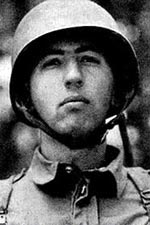Herbert Sobel
Herbert Sobel | |
|---|---|
 | |
| Born | 26 January 1912 Chicago, Illinois |
| Died | 30 September 1987 (aged 75) Waukegan, Illinois |
| Allegiance | United States |
| Service/ | United States Army |
| Years of service | 1941–1946 c. 1950–1953 |
| Rank | Lieutenant Colonel |
| Service number | 0304109 |
| Unit | Easy Company, 2nd Battalion, 506th Parachute Infantry Regiment, 101st Airborne Division |
| Battles/wars | World War II Korean War |
| Awards | Bronze Star Medal |
| Other work | Accountant |
Herbert Maxwell Sobel Sr. (26 January 1912 – 30 September 1987)[1] was an American commissioned officer with Easy Company, 2nd Battalion, 506th Parachute Infantry Regiment, in the 101st Airborne Division during World War II. Sobel was portrayed in the HBO miniseries Band of Brothers by David Schwimmer.
Early life and education[]
Sobel was born in Chicago, Illinois, to a Jewish family.[2] He attended the Culver Military Academy in Indiana.[3] He was a clothing salesman.[4] He graduated from the University of Illinois, majoring in architecture.[4]
Military career[]
Sobel enlisted in the United States Army on 7 March 1941 and volunteered for the paratroopers. He was commissioned as a second lieutenant. Promoted to first lieutenant, Sobel commanded Company E for all of their basic training at Camp Toccoa, Georgia. He trained his men intensively, and was eventually promoted to the rank of captain in recognition of his ability as a trainer. However, Sobel was despised by his soldiers for being petty and vindictive.[5]
After a period of training in the United Kingdom before the Normandy invasion, Sobel was reassigned from command of Easy Company to command the jump school at Chilton Foliat. First Lieutenant Thomas Meehan replaced Sobel, and was one of several officers (including Richard Winters) to succeed him in that post before the end of the war.[6]
Sobel jumped into Normandy and earned a Combat Infantryman Badge as part of Regimental Headquarters Company.[6]
Sobel was assigned as the regimental S-4 (logistics) officer on 8 March 1945.[7]
Later life and death[]
Sobel returned to the United States in 1945,[8] and was honorably discharged from the Army on 18 March 1946. He worked as an accountant before being recalled to active duty during the Korean War.[9] He remained in the Army National Guard, eventually retiring at the rank of lieutenant colonel.[citation needed] He later married and had three children.[10]
In 1970, Sobel shot himself in the head with a small-caliber pistol in an attempted suicide.[11] The bullet entered his left temple, passed behind his eyes, and exited the other side of his head. Both of his optic nerves were severed by the shot, leaving him blind.[11] Soon afterward, he began living at a VA assisted-living facility in Waukegan, Illinois. He died there of malnutrition on 30 September 1987.[11][12] No memorial services were held for him.[11]
Legacy[]
Sobel was portrayed as a petty and capricious martinet in the television series Band of Brothers, generating much debate.[13] Stephen Ambrose gives numerous examples of this in his book.[14] Since the series, his son Michael Sobel has spoken out on his behalf.[13] In interviews, some Easy Company veterans have acknowledged the part Sobel's training played in the company's later successes. Writing of him in their autobiographies, he is recalled with little fondness by fellow officers, who regarded him as a dilettante in the practical matters of ground combat, particularly due to his pronounced lack of understanding of common infantry field craft such as land navigation and basic infantry combat tactics, as well as a refusal to listen to the advice of fellow officers or NCOs.[citation needed]
Honors and awards[]
 Combat Infantryman Badge
Combat Infantryman Badge Parachutist Badge
Parachutist Badge Bronze Star Medal
Bronze Star Medal American Defense Service Medal
American Defense Service Medal American Campaign Medal
American Campaign Medal European-African-Middle Eastern Campaign Medal
European-African-Middle Eastern Campaign Medal World War II Victory Medal
World War II Victory Medal National Defense Service Medal
National Defense Service Medal
References[]
- ^ "LTC Herbert Maxwell Sobel (1912-1987) - Find A..." www.findagrave.com. Retrieved 27 May 2021.
- ^ Ambrose 1992, p. 17
- ^ The Roll Call. Culver, Indiana: Culver Military Academy. 1929. p. 163. Retrieved 7 March 2017.
- ^ Jump up to: a b Brotherton 2009, p. 241
- ^ Ambrose 1992, chap 1–3
- ^ Jump up to: a b Ambrose 1992, p. 53
- ^ Ambrose 1992, p. 240
- ^ "New York, New York Passenger and Crew Lists, 1909, 1925–1957". Retrieved 8 March 2017.
- ^ Brotherton 2009, p. 242
- ^ Ambrose 1992, p. 298
- ^ Jump up to: a b c d Brotherton 2009, p. 244
- ^ "Illinois, Cook County Deaths, 1878–1994". Retrieved 8 March 2017.
- ^ Jump up to: a b Brotherton 2009, p. 95
- ^ Ambrose 1992
Bibliography[]
- Ambrose, Stephen E. (1992). Band of Brothers: Easy Company, 506th Regiment, 101st Airborne from Normandy to Hitler's Eagle's Nest. Simon & Schuster. ISBN 978-0-7434-6411-6.
- Brotherton, Marcus (2009). We Who Are Alive and Remain: Untold Stories from The Band of Brothers. Berkley Caliber. ISBN 978-0-425-23419-8.
- Compton, Lynn D.; with Brotherton, Marcus (2008). Call of Duty: My Life Before, During, and After the Band of Brothers. Berkley Caliber. ISBN 978-0-425-21970-6.
External links[]
- 1912 births
- 1987 deaths
- United States Army personnel of World War II
- Band of Brothers characters
- People from Chicago
- Military personnel from Illinois
- United States Army officers
- University of Illinois School of Architecture alumni
- Operation Overlord people
- Jewish American military personnel
- Culver Academies alumni
